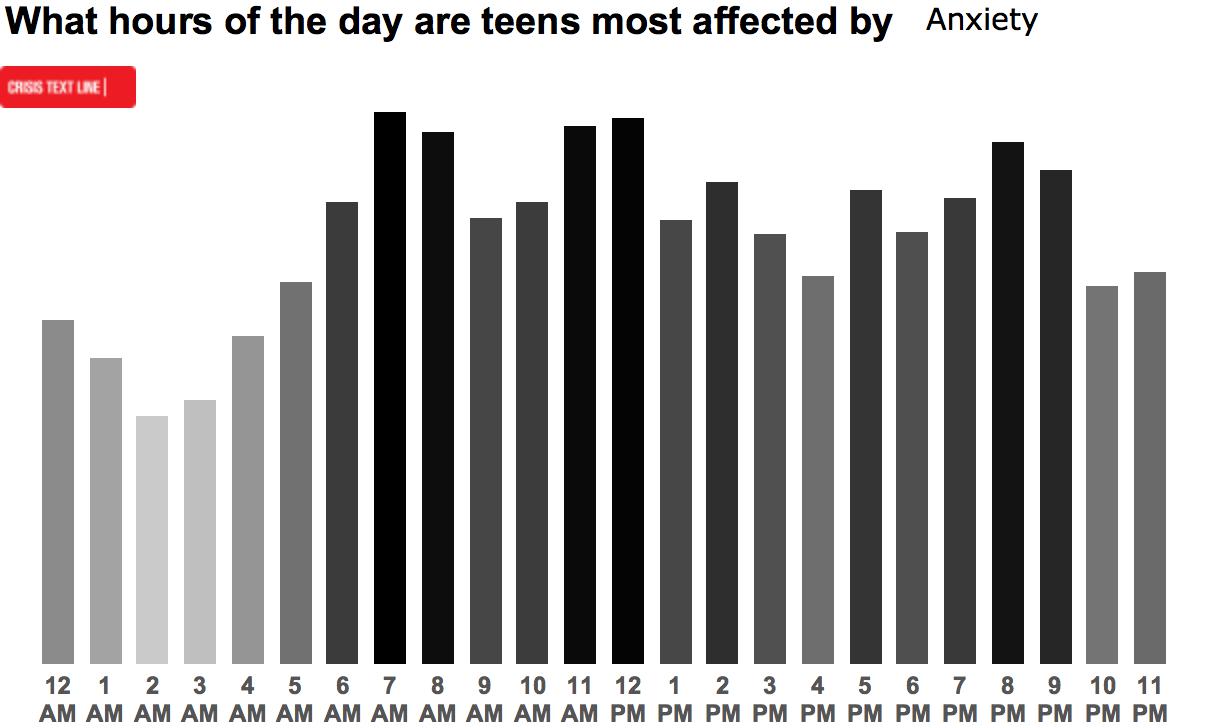
What open data can tell us about depression
Bob Filbin is the chief data scientist at Crisis Text Line, a winner of Knight News Challenge: Health.
Every day, thousands of teens face bullying, abuse and family conflicts. Many struggle with depression, self-harm or even thoughts of suicide. Launched in August 2013, Crisis Text Line offers free, 24/7 text support to teens nationwide. Since then, teens have exchanged over 3 million messages with trained specialists about the crises they face.

What hours of the day are teens affected by anxiety?
Crisis Text Line is the largest service for teens on the medium they use and trust the most: texting. Many teens who use Crisis Text Line are seeking crisis support for the first time. Others tell us they’ve tried other services that offer phone support or online chat, but they prefer texting. This means Crisis Text Line is collecting unprecedented data on the crises teens face.
One way Crisis Text Line uses its data is to help provide the best possible experience to teens who use our service. For example, we can see when teens struggle the most with anxiety (7 a.m. during the school week), and schedule specialists to help them accordingly. But we also recognize our data, in the hands of citizens and journalists, has the potential to prevent crises from happening. That’s why Crisis Text Line developed Crisis Trends. Using data from specialist reports, Crisis Trends empowers journalists, researchers and citizens to identify trends in how teens experience crises over time and by state.
One early insight from Crisis Trends is what days of the week LGBTQ services should be available. Crisis Trends shows that LGBTQ youth reach out for the most help in the early part of the week, especially on Sundays and Wednesdays, and the least on Fridays and Saturdays. Many services don’t have the capacity to be available 24/7. For services that may be closed on the weekends, it’s worth re-examining local demand during those times.
I’m particularly excited that Crisis Trends will allow citizens to uncover their own insights. Teens who use Crisis Text Line face a wide range of crises, including bullying, parental divorce and academic stress. Our staff has strong expertise in crisis support, but not on every issue. The interactive design of Crisis Trends allows citizens to leverage specific expertise to interpret the data in ways that we can’t. We’ll be launching a blog in the coming weeks to provide a space for citizens to share their insights.
Crisis Trends is part of a growing effort by tech-savvy nonprofits to create open data. We believe data can provide more value if it’s shared beyond organizational borders, to journalists and others who want to make a difference but are starved for resources that will show how they can be most helpful. In this spirit, Crisis Trends will be a living project; we will update it with the latest data at least once a week, so people can always see the latest trends in how teens experience crisis.
With fall classes starting, teens will be facing new challenges and struggles; Crisis Trends will be there to complement anecdotes with data-driven insights. We hope it is the first step towards a richer, more data-driven discussion on how to best help teens in crisis and prevent future crises from happening.Learn About Tableau
Recent Content
-
Journalismarticle ·
-
Journalismarticle ·
-
Journalismarticle ·


